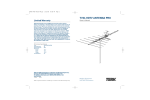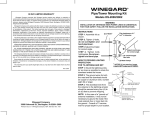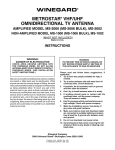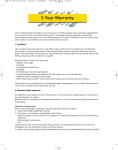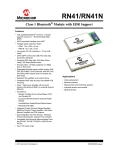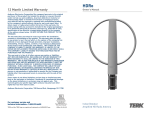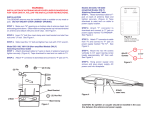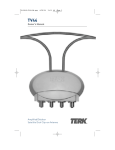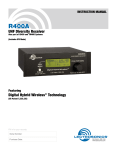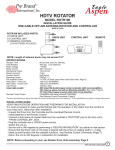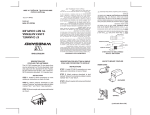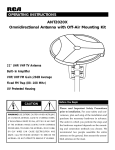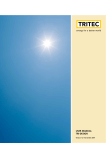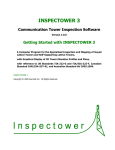Download TV38 HDTV ANTENNA PRO
Transcript
T0437-TV38 Revise-OM.qxp 11/11/03 04:34 AM Page 1 TV38 HDTV ANTENNA PRO Limited Warranty Owner’s Manual TERK Technologies Corp. (TERK) warrants this product against defects in materials or workmanship for one (1) year from the date of purchase. During this warranty period, this product will be replaced without charge. This warranty does not cover any damage due to acts of nature, commercial use, accident, misuse, abuse or negligence. This warranty is only valid in the USA. Replacement as provided under this warranty is the exclusive remedy of the consumer. TERK shall not be liable for any incidental or consequential damages for breach of any express or implied warranty on this product, except to the extent that limitations of this sort are prohibited by applicable law. THERE ARE NO IMPLIED WARRANTIES OF MERCHANTABILITY OR FITNESS FOR A PARTICULAR PURCHASE EXCEPT TO THE EXTENT THAT IMPLIED WARRANTIES OF EITHER SORT ARE REQUIRED BY APPLICABLE LAW, AND IN SUCH CASE, EACH WARRANTY IS LIMITED IN DURATION TO ONE YEAR. Performance Specifications Type: Active Elements: Antenna Selector: Dimensions: Height: Width: Length: Turning Radius: HDTV/UHF/VHF/FM 43 Pink 311/2" 111" 1493/4" 90” TERK and TERK Technologies are trademarks of TERK Technologies Corp. Commack, NY ©2003 TERK Technologies Corp. Made in USA. For additional information: call 1.800.942.TERK (8375) or visit www.terk.com. 113P006A 1450191 TERK is a registered trademark. The TERK logo is a trademark of the TERK Technologies Corp. Large Directional UHF/VHF/FM Antenna T0437-TV38 Revise-OM.qxp 11/11/03 04:34 AM Page 1 Safety Precautions TV38 TV38 WARNING READ ALL OF THE ATTACHED SAFETY INSTRUCTIONS BEFORE PROCEEDING WITH ANTENNA AND/OR MAST ASSEMBLY AND INSTALLATION. INSTALLATION OF THIS ANTENNA NEAR POWER LINES IS DANGEROUS. FOR YOUR SAFETY, FOLLOW THE INSTALLATION INSTRUCTIONS. Safety Precautions (continued) Use extreme caution when installing or removing an outdoor antenna that is located close to overhead wires such as power lines, telephone lines or cable TV lines. If any part of the antenna makes contact with overhead power lines, touching the antenna or the antenna cable can cause electrocution and death. If the antenna is in contact with any type of overhead wires, call your power company and ask them to send a qualified technician to remove the antenna. Do not attempt to remove it yourself. Important Safety Precautions: Many do-it-yourself and professional antenna installers are injured or killed each year by electric shock. While anyone can see the obvious danger of falling, the most resourceful sometimes fail to recognize overhead wires as being potentially lethal. To touch any part of the antenna to these overhead wires is the same as touching the wires with your bare hand. A very serious shock is almost sure to result when contacting an electrical wire, and in the case of primary wires on the top of poles, the shock is like being struck by a bolt of lightning. Many power wires are within 20 to 25 feet of the ground and could easily be touched by an assembled antenna. If you are not completely sure that you can install the antenna safely, Do Not Try It! Contact a professional installer instead. Follow These Rules and Live: 1. Perform as much antenna assembly on the ground as possible. 2. Watch out for overhead power lines and be sure to select an antenna site well away from all overhead wires. Check the distance to the power lines before you start installing. It is recommended that you stay a minimum of twice the length of the antenna plus the length of the mast away from ALL power lines. 3. Do not use a metal ladder. 4. Remember, even the slightest touch of the antenna to a power line can cause a fatal shock. Do not try to guess which overhead wires carry high voltage - check with the power company. 5. Never install the antenna outdoors at night, when it is windy, or during rain or snow. 6. Have a spotter when you are on the roof; they can see things you may miss. 7. If you start to drop the antenna, let it go. You could lose your balance and fall also. 8. If anything comes into contact with a power line - CALL YOUR POWER COMPANY! DO NOT ATTEMPT TO REMOVE IT YOURSELF! They will remove it for you. 9. Mast, downlead and guy wires are all excellent conductors. Keep them away from power lines also. Do not run the downlead cable over power wires. 10. Make sure the antenna installation is secure. 11. Do not stand on, lean on, hang from or hang anything on the antenna once it is mounted. 12. Make sure the antenna mast assembly and downlead are grounded per National Electrical Code. (See page 14.) Lightning Protection and Grounding: • Always plug your TV and other electronic devices into a quality surge protector (such as the TERK TSP-6), for maximum protection against lightning and power surges. • Do not run the downlead cable over power wires. • Make sure the antenna downlead is connected to suitable lightning arrestors. 1 2 T0437-TV38 Revise-OM.qxp 11/11/03 04:34 AM Page 3 Antenna Assembly Antenna Assembly (continued) TV38 TV36 Boom Brace Large Boom 1. Unfold the elements on the two reflector booms until they lock into place. Make sure that they are straight and perpendicular to the boom. 2. Attach the two reflector booms using the attached nut and bolt so that they are perpendicular to the smaller boom. (See figure 1.) Rear Boom Front Boom Fig. 1 Mast Reflector Booms 3. Unfold the reflector booms until they lock into place. (See figure 2.) Fig. 2 4. Unfold all the other elements on the antenna until they lock into place ensuring that they are flat and parallel to each other. (See figure 3.) Fig. 3 3 4 T0437-TV38 Revise-OM.qxp 11/11/03 04:34 AM Page 5 Antenna Assembly (continued) TV38 TV38 5. Find the larger antenna section and remove the nut and bolt. Slide the narrow boom of the front antenna into the larger section. Tap lightly with a rubber mallet on the end of the small boom aligning the bolt holes. (See figure 4.) Re-install the bolt and nut; be sure to tighten it securely. Antenna Assembly (continued) NOTE: Make sure that the side of the small boom with the phasing lines line up with the nuts on the large boom. 7. Remove the rear nut and bolt from the larger antenna section. Slide the narrow boom of the rear antenna into the larger section. Tap lightly with a rubber mallet on the end of the small boom, aligning the bolt holes. (See figure 6.) Re-install the bolt and nut; be sure to tighten it securely. 8. Remove the nut and washer from the top of the last element holder stud on the top side of the antenna and repeat the process on the last element holder stud on the bottom side of the antenna. (See figure 6.) Place the phasing lines from the rear section over the stud, one on the top side, one on the bottom, and reattach the washers and hex nuts. Tighten them securely. Fig. 4 Fig. 6 6. Remove the nuts and washers from the top of the first element holder studs. (See figure 5.) Place the phasing lines from the front section over the studs, and re-attach the washers and hex nuts. Tighten them securely. 9. Lay the boom brace on top of the antenna keeping all the U-bolts on the same side. Locate the bolt hole in the corner reflector and attach the brace with the bolt and nut. Swing the boom brace down towards the rear. Form a "V" with the metal straps. Bolt the “V” to each side of boom. (See figures 7 and 8.) Phasing Lines Fig. 5 Fig. 7 5 6 Fig. 8 T0437-TV38 Revise-OM.qxp 11/11/03 04:35 AM Page 7 Antenna Assembly (continued) Antenna Assembly (continued) TV38 TV38 10. Loosen the nuts on the downlead connections. Attach the transformer ends to the studs, between the washers, and tighten the nuts securely. (See figure 9.) Attach the coax downlead to the transformer. Fig. 9 11. Loosen the U-bolt nuts, slide the TV38 antenna over the mast and lightly tighten the two mast clamps. (See figure 10, 11.) The top side of the antenna is the side with the black plastic pieces on it. NOTE: The top side of the antenna is the side with the black plastic pieces on top of the large boom. Fig. 10 Fig. 11 12. Connect the coax downlead to your TV. Rotate the TV38 antenna until you receive the best picture. You will probably need a helper to view the TV set while you are rotating the antenna. See “Pointing the Antenna Towards the Broadcast Tower” Downlead Connections Transformer Point this end towards the broadcast tower NOTE: Point the small end of the antenna towards the station broadcast tower. 13. Tighten the two mast clamps securely. 14. Secure the coaxial downlead to the mast (using cable ties) to prevent it from whipping by the wind. 15. Ground the antenna and mast per the accompanying grounding instructions. (See page 14.) 7 8 Pointing the Antenna Towards the Broadcast Tower 1. Go to www.terk.com and click on the “Antenna Locator.” 2. Enter your home address and then “Submit.” 3. Click “View Street Level Map” to see in which direction you should face your antenna. T0437-TV38 Revise-OM.qxp 11/11/03 04:35 AM Page 9 General Installation Instructions for Mast Mounted Antennas TV38 TV38 1. Assemble your antenna on the ground at the installation site per the instructions. 2. On the ground, attach the antenna to the mast. Pull enough coax downlead and connect to the antenna per its instructions. 3. To insure that the mast does not fall, a durable nonconductive rope should be attached to each ten foot section as it is raised. 4. Install the selected mounting bracket. 5. If you are using guy wire installation (not included) instead of a mounting bracket: • Install guy anchor bolts. • Estimate length of guy wire and cut. • Attach to mast using a guy ring. 6. Carefully take the antenna and mast assembly to the mounting bracket and insert. Tighten the clamp bolts. In case of a guyed installation, it will be necessary to have at least a second person hold the mast upright while the guy wires are attached and tightened to the anchor bolts. Where To Install Your Antenna Before attempting to install your antenna, decide on the best location to install your antenna for both safety and performance. To determine a safe distance from wires, power lines and trees: 1. Measure the length of your antenna and multiply by 2. 2. Add this measurement to the length of your tower/mast. If you are unable to maintain this safe distance, STOP! Get professional help. Most antennas are supported by tripod masts or pipe masts attached to the chimney, roof, or to the side of the house. Generally, the higher the antenna, the better it performs. Good practice is to install your antenna about 5 to10 feet above the roof line and away from power lines and other obstructions. NOTES: • Remember when doing any installation, keep the mast plumb. Antenna Removal Removal of the antenna should be exactly the reverse of the installation instructions. Please, for your own safety, follow the instructions for installing the antenna starting with the last step first. • For mast support, use only 1-1/4” O.D. pipe or larger antenna mast sections. Lengths over 10 feet should be guyed at least every 10 foot section. • Not all mounting methods are shown here. Read and follow the mount manufacturer’s instructions carefully. House Construction Obstacles: For homes made of stucco, clad with aluminum siding or that have internal foil paper insulation, the antenna must be installed on the side of the house that faces the broadcasting tower. These materials may prevent signals from going through it. 9 10 T0437-TV38 Revise-OM.qxp 11/11/03 04:35 AM Page 11 Types of Support Structures and Mounting Fig. 12 TV38 TV38 Chimney Mount - Mounts on a chimney only Types of Support Structures and Mounting (continued) Suggested height limitation: 10 feet above chimney top. The chimney is often an easy and convenient mounting place, but the chimney must be strong enough to support the antenna in high winds. Do not use a chimney that has loose bricks or mortar. A good chimney mount consists of a 5 or 10 foot 1-1/4” diameter steel mast and two heavy duty strap clamp-type brackets. Attic An attic installation is the easiest, fastest and most convenient type of antenna installation, especially if you do not have easy or secure access to an outdoor area. Attic installations work best in areas where strong signals are present. Roofing materials, aluminum foil on insulation, aluminum or steel siding, metal gutters at the attic level, and metal lath under old plaster walls all can interfere with reception. Use the universal mount to secure the mast and antenna to a rafter. 1. Insert the threaded end of the strap hook, (the one secured to the strap) through the end portion of the “Z” mount (hole A). Take one of the loose strap hooks and insert into hole B. NOTE: It is important to thread the nut only 1/4” onto the hook, so that it may later be tightened to take out the slack and make the strap secure to the chimney. 1. Screw the universal mount into a supported rafter or beam. 2. Using the U-bolt, bracket and nuts, secure the mast to the universal mount. 3. After you align the mast perpendicular to the floor, tighten the nuts securely. 2. Go around the chimney with the strap; slip the strap clip onto the strap, and then secure the other end of the strap by inserting the strap into the strap hook that is in hole B. The strap clip is used as follows: (See figure 12.) a. Slide the strap through the loop section of the clip and bend it around through the upright section of clip. b. Bend the upright sections of the clip down with pliers, pinching the strap firmly. 3. At this time, remove any slack in the strap by tightening the nuts at holes A and B. 4. Repeat the above steps to secure the lower mount to chimney. (It is recommended that the mounts be a minimum of 18” apart.) 11 NOTE: Install the upper bracket just below the top course of bricks, and the lower bracket two or three feet below the upper bracket. For maximum strength, space the brackets as far apart as possible. 5. Place the mast against the mount and secure it in place using the mast support clamps and nuts. Universal Mount - For attic installations 12 T0437-TV38 Revise-OM.qxp 11/11/03 04:35 AM Page 13 Types of Support Structures and Mounting (continued) TV38 TV38 Wall Mount Example of Antenna Grounding NOTE: Grounding the antenna and mast provides lightning protection for the antenna and your TV set. All outdoor antenna installations should be properly grounded. To effectively protect the installation, the coaxial cable(s) should be grounded before they enter the house. The grounding of the coaxial cable is made using a “ground block” and copper wire (not supplied). For information and the materials needed to ground your antenna installation, visit your local electronics store. If you are not sure how to install the grounding block and rod, please consult your local retailer or TERK’S Technical Support Department at 1-800-942-8375. Suggested height limitation: 10 feet above the rooftop. An outside wall of your home is also an easy and convenient mounting place, but the wall and fasteners that you use must be strong enough to support the antenna in high winds. Ensure that the brackets are securely fastened to a solid part of your wall. Example of antenna grounding as per National Electrical Code, ANSI/NFPA 70 1. Space the mounting brackets on an exterior wall – be sure to clear roof eaves or any other obstacles. 2. Secure the brackets to the wall using the 4 lag screws. 3. Insert the mast between the saddles and secure with the nuts and bolts. Grounding Wire Conductors (NEC Section 810-21) Electric Service Equipment Tripod Mount (not included) - Used on peaked and flat roofs Suggested height limitation: 10 feet above the rooftop. Installation involving a tripod mount and a mast should be guyed if the mast is ten feet or more. The tripod mount must be securely anchored to the roof as should the guy wires. Apply roofing compound around the base of the brackets, screws and eyebolts to weather proof the holes in the roof. Try to lag bolt the legs to the roof rafters. If not, install wood plates in the attic and install bolts to secure the mount. Power Service Grounding Electrode System (NEC Art 250, Part H) Antenna Discharge Unit (NEC Section 810-20) Ground Clamps Rain Drip Loop On Lead-in To TV NEC - National Electrical Code 1. Mount the 75 ohm grounding block or discharge unit as close as possible to where the downlead enters the house. 2. The ground wires for both the mast and the downlead should be copper or aluminum wire, number eight (8) or larger. 3. The downlead wire from the antenna to the antenna grounding block or discharge unit and the mast ground wire should be secured to the house with stand-off insulators, spaced from four (4) to six (6) feet apart. Telescopic Mast (not included) The minimum safe diameter of the mast is 1-1/4 inches for this type of mount. Guy wires should be equally spaced in at least three directions. Use at least three guy wires for each ten foot section of mast. Make sure guy wires are spaced evenly apart. 13 Antenna Lead in Wire Ground Clamp NOTE: In the case of a “ground up” antenna installation, it may not be necessary to ground the mast if the mast extends four or more feet into the ground. Consult a TV serviceman for the proper depth in your location. 14








